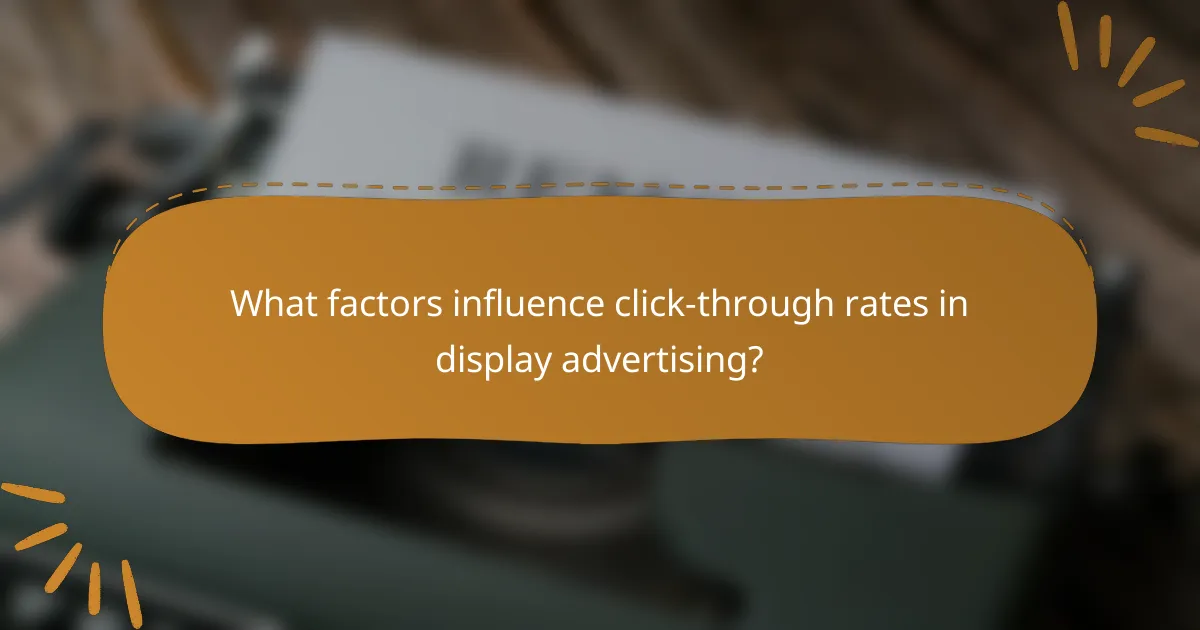In the ever-evolving landscape of digital marketing, understanding ad formats and their impact on click-through rates (CTR) is crucial for success. Various ad types, including display, video, native, social media, and search ads, each offer distinct advantages that can significantly affect user engagement and conversion. Additionally, CTR varies widely across industries, shaped by factors such as audience interaction and ad relevance, making it essential for businesses to adapt their strategies accordingly.

What are the most effective ad formats for maximizing click-through rates?
The most effective ad formats for maximizing click-through rates (CTR) often include display ads, video ads, native ads, social media ads, and search ads. Each format has unique characteristics that can influence user engagement and conversion rates, making it essential to choose the right type based on your target audience and campaign goals.
Display ads
Display ads are visual advertisements placed on websites, typically in the form of banners or sidebars. They can effectively capture attention, especially when designed with compelling graphics and clear calls to action. However, their effectiveness can vary widely depending on placement, design, and audience targeting.
To improve CTR with display ads, focus on high-quality images, concise messaging, and strategic placement on relevant websites. A/B testing different designs and messages can help identify what resonates best with your audience.
Video ads
Video ads are increasingly popular due to their ability to engage viewers through storytelling and dynamic content. These ads can be placed on platforms like YouTube or social media, often leading to higher engagement rates compared to static ads. However, they require more resources to produce and may not be suitable for all budgets.
For effective video ads, keep them short and to the point, ideally under 30 seconds, and ensure they are optimized for mobile viewing. Including a strong call to action at the end can significantly boost CTR.
Native ads
Native ads blend seamlessly with the content of the platform they appear on, making them less intrusive and more engaging for users. These ads often take the form of sponsored articles or posts that match the look and feel of the surrounding content. Their subtlety can lead to higher CTRs, as users are more likely to engage with content that feels organic.
To maximize the effectiveness of native ads, ensure the content is relevant and valuable to the audience. Clear labeling as sponsored content is essential to maintain transparency and trust.
Social media ads
Social media ads leverage platforms like Facebook, Instagram, and Twitter to reach targeted audiences based on demographics, interests, and behaviors. These ads can take various forms, including image, video, carousel, and story ads, allowing for creative flexibility. The interactive nature of social media can lead to higher engagement and CTR.
To enhance CTR on social media, use eye-catching visuals and concise messaging. Engaging with users through comments and direct messages can also foster a sense of community and encourage clicks.
Search ads
Search ads appear on search engine results pages when users enter specific keywords. These ads are highly targeted, as they reach users actively searching for related products or services. This intent-driven approach often results in higher CTRs compared to other formats.
To optimize search ads, conduct thorough keyword research and use compelling ad copy that addresses user needs. Regularly monitoring and adjusting bids based on performance can help maintain a competitive edge in search results.

How do click-through rates vary by industry?
Click-through rates (CTR) differ significantly across industries, influenced by factors such as audience engagement, ad placement, and content relevance. Understanding these variations can help businesses tailor their advertising strategies to improve performance.
Retail industry CTR trends
The retail industry typically experiences higher CTRs, often ranging from low to mid-single digits. Seasonal promotions and targeted campaigns can significantly boost engagement, especially during holidays or sales events.
Effective strategies include using visually appealing ads and personalized offers. Retailers should focus on mobile optimization, as a large portion of shopping traffic comes from mobile devices.
Technology industry CTR trends
In the technology sector, CTRs generally hover around mid-single digits, with variations based on the product type and target audience. Innovative and informative content tends to attract more clicks, particularly for new product launches.
Tech companies should leverage educational content, such as webinars and tutorials, to enhance engagement. Additionally, utilizing retargeting strategies can help capture interest from potential customers who previously interacted with the brand.
Healthcare industry CTR trends
The healthcare industry often sees lower CTRs, typically in the low single digits, due to the sensitive nature of the content and the need for trust. Ads that provide clear, valuable information tend to perform better.
Healthcare providers should focus on transparency and patient education in their advertising. Using testimonials and case studies can help build credibility and encourage clicks.
Finance industry CTR trends
In the finance sector, CTRs are usually in the low single digits, influenced by the cautious nature of consumers regarding financial decisions. Ads that emphasize security and reliability can improve engagement rates.
Financial institutions should prioritize clear messaging and straightforward calls to action. Offering free resources, such as financial planning tools or guides, can also attract potential clients and increase CTR.

What factors influence click-through rates in display advertising?
Click-through rates (CTR) in display advertising are influenced by several key factors, including ad placement, design, targeting accuracy, and audience engagement. Understanding these elements can help advertisers optimize their campaigns for better performance.
Ad placement
Ad placement refers to where ads appear on a webpage or within an app. Ads positioned above the fold, or in prominent areas, typically achieve higher CTRs compared to those placed at the bottom or in less visible spots. Testing different placements can help identify the most effective locations for your target audience.
Consider the context of the content surrounding the ad. Ads that align with relevant content can attract more attention and clicks. For example, a travel ad on a vacation blog may perform better than the same ad on a finance site.
Ad design
The design of an ad plays a crucial role in capturing attention and encouraging clicks. Effective ads often use bold colors, clear fonts, and compelling images that resonate with the target audience. A well-designed ad should also include a strong call-to-action (CTA) that prompts users to take the desired action.
Keep in mind that simplicity can enhance effectiveness. Overly complex designs may confuse viewers, leading to lower CTRs. Aim for a clean layout that communicates the message quickly and clearly.
Targeting accuracy
Targeting accuracy involves reaching the right audience with your ads. The more accurately you can target your ads based on demographics, interests, and behaviors, the higher the likelihood of achieving a good CTR. Utilizing data analytics and audience segmentation can significantly improve targeting efforts.
Consider using retargeting strategies to reach users who have previously interacted with your brand. This approach often results in higher engagement and click-through rates, as these users are already familiar with your offerings.
Audience engagement
Audience engagement measures how actively users interact with your ads. Engaging content that resonates with viewers can lead to higher CTRs. This can be achieved through storytelling, humor, or addressing pain points that your audience faces.
Monitoring engagement metrics, such as time spent on the ad or interaction rates, can provide insights into what resonates with your audience. Adjusting your strategy based on these metrics can help improve overall performance and CTR in future campaigns.

What are the current trends in ad formats for 2024?
In 2024, ad formats are increasingly focused on engaging consumers through innovative strategies, particularly video content and personalization. These trends reflect the evolving preferences of audiences and the need for brands to adapt to maintain effective communication.
Increased use of video content
Video content continues to dominate advertising strategies, with brands leveraging short-form videos on platforms like TikTok and Instagram. This format captures attention quickly, often leading to higher engagement rates compared to static ads.
Marketers should consider incorporating video into their campaigns, as it can enhance storytelling and brand recall. A good practice is to keep videos concise, ideally under 30 seconds, to cater to the short attention spans of online users.
Personalization in ads
Personalization is becoming a critical component of effective advertising, allowing brands to tailor messages based on user data and preferences. This approach can significantly improve click-through rates by making ads more relevant to individual consumers.
To implement personalization, advertisers should utilize data analytics to understand their audience better. Techniques such as dynamic content and targeted messaging can create a more engaging experience, leading to increased conversions. However, brands must also be mindful of privacy regulations to ensure compliance while gathering user data.
